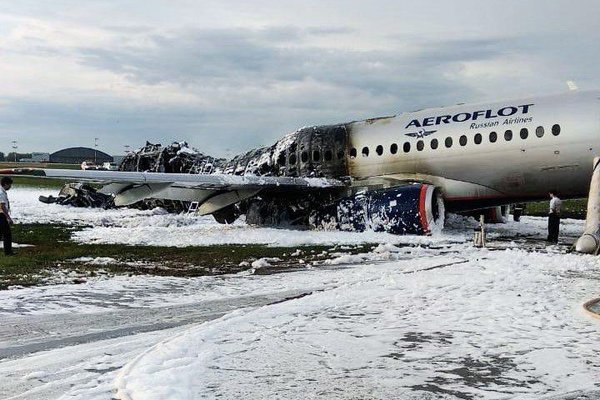When an Aeroflot jet came to a fiery emergency landing in Moscow over the weekend, videos of the accident were posted across social media, revealing that in the midst of the chaos some travelers apparently used precious moments to grab their carry-on bags.
A radio station, Kommersant FM, reported that some passengers slowed evacuation of the plane by trying to retrieve luggage while people behind them tried to exit the plane. The news agency Interfax reported that as some passengers reached for their bags, others were stuck in the single-aisle, Russian-built plane. At least 40 people died.
Airplane passengers who insist on getting their belongings out of overhead bins in times of crisis have become a major concern for flight attendants, whose job it is to evacuate planes quickly in times of trouble.
“We have seen this issue of passengers trying to get their bags in an emergency over and over again in recent accidents,” said Sara Nelson, president of the Association of Flight Attendants-CWA union. “This has been identified as a safety risk by the National Transportation Safety Board and confirmed by the Federal Aviation Administration.”
Although plane crashes are rare, many travelers fear flying. Part of that fear stems from anxiety that if something did go wrong on a plane, passengers would be unable to do anything to help themselves.
But that’s not quite true. There are steps — besides leaving their carry-ons behind — passengers can take to improve their odds, both before boarding a plane and after taking their seats.
Here are some tips.
Wear practical clothes.
When dressing for your travels, avoid materials that are very flammable, like nylon and polyester. Try to wear long sleeves and long pants that can protect your skin from potential burns and cuts.
“Wear shoes that lace up or stay on,” Ms. Nelson said. “No flip-flops, and heels aren’t recommended, especially stilettos. You want something that can be tied onto your feet. Keep the shoes on.”
You should also keep your identification cards in a pocket, suggested Frank Jackman, a spokesman for the Flight Safety Foundation, a nonprofit organization that provides guidance and resources for the aviation and aerospace industry.
If you can, take a direct flight.
Flying remains one of the safest ways to travel, but a 2017 study by Boeing found that most accidents happen during takeoff or landing. The fewer flights you take, the less taking off and landing you’ll have to do, so . . .
Try to sit toward the back of the plane, in an aisle seat.
The Federal Aviation Administration says there is no “best” seat on planes, but many people believe that sitting in the rear of a plane, in an aisle seat, is the safest place to be.
A 2015 analysis of flight deaths by Time magazine found that seats in the back third of planes had a 32 percent fatality rate. That compares with 38 percent in the front third and 39 percent in the middle. Though it may be worth noting that in the Aeroflot disaster, the back was the worst place to be: People there were trapped.

Pay attention to where the exits are.
When you get on a plane, the first thing you should do is look for the exits. And remember, as flight attendants and safety videos and manuals say, “the nearest exit could be behind you.”
“Take note of where you’re sitting and pay attention to what’s happening around you,” Ms. Nelson said. “Know where the exits are and who the flight attendants that can help you are.”
You should also count the number of rows between your seat and the exit row: If there’s smoke and you can’t see the exit, you can count your way to it.
Listen to the safety briefing. Read the instruction card.
Yes, the safety briefing can feel tedious — but it may also save your life. People who pay attention to the briefing, even if they don’t remember everything they are told or everything they read, will have a better idea of what to do in an emergency, Ms. Nelson said.
“People who pay attention to the safety briefing have awareness around them,” she said.
Even Mr. Jackman, the Flight Safety Foundation spokesman, tries to keep an ear open. “I can’t say that I listen to the safety briefing with all my attention,” he said, “but it’s worth doing it because it has a lot of important reminders.”
Know how to buckle, adjust and unbuckle your seatbelt.
First-time fliers might not know how to put a seatbelt on a plane on, and experienced travelers could have a hard time with it if they are nervous or panicking. But being comfortable with the use of a belt could make a big difference in an emergency.
“Knowing how to use your seatbelt could really affect your ability to survive,” Ms. Nelson said.
Keep your electronic devices to a minimum.
If you need to have your phone, laptop and other devices out, keep cords out of the way. And keep the devices close to you, so they don’t go flying about.
“You’re not supposed to have your personal devices plugged in, because that can be a hazard,” Ms. Nelson said. “Anything that can move about the cabin when extreme force happens can potentially hurt others on the flight.”
Let’s say this one more time.
If you have to evacuate, leave your things behind. Just get out as quickly as you can.
“There’s not much in your carry-on luggage worth dying for,” Mr. Jackman said. “And you wouldn’t want to be the reason for someone else getting injured.”






